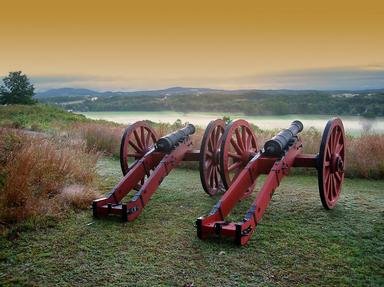Quiz Answer Key and Fun Facts
1. What is the word for the round knob on the end of a gun tube?
2. What is the word for the rope with a hook at one end and a handle at the other used to fire a friction primer?
3. What is the block of wood or metal at the end of a round called?
4. The iron circle at the end of a gun's trail that fits into the pintle hook on a limber so it can be pulled?
5. What was the name given to the M1841 12-pounder that was developed to be carried in pieces on the backs of three mules?
6. Called "An American cannon" this type of gun is considered the first piece of purely American designed ordnance.
7. The 17,000 pound "Dictator" was a 13 inch sea-coast gun of one of these types. Which?
8. The most common smoothbore artillery piece of the war was this 12-pounder.
9. A tin cylinder filled with 27 iron balls attached to a sabot and powder bag used in anti-personnel firing?
10. How many guns were there on the USS Monitor?
11. What was the weight of the largest shell thrown by the 13-inch sea-coast mortar?
12. When two or more pieces of field artillery moved frequently and rapidly along a battle line, what was this called?
13. What artillery shot consisted of two iron plates connected by a bolt, with nine or more cast-iron balls between them?
14. When a battery succeeded in firing on the length of an enemy troop movement what was this action called?
15. Who was killed when the cannon he was manning accidentally exploded April 14, 1861 at Fort Sumter, making him the first man killed in the Civil War?
16. What city did the "Washington artillery" call home?
17. What was the nick-name that the Yankees gave a 7.44-inch English Blakely at Vicksburg, because of the peculiar noise that its projectiles made when they whizzed through the air?
18. What was the name of the man in charge of arming the CSS Virginia?
19. From where did the Federal cannon fire across the Rappahannock River, into Fredericksburg?
20. What was the nickname given to the 9-inch Parrott gun with which the Federals shelled Charleston, South Carolina on August 22-23, 1863?
Source: Author
ricbatcheller
This quiz was reviewed by FunTrivia editor
bloomsby before going online.
Any errors found in FunTrivia content are routinely corrected through our feedback system.

